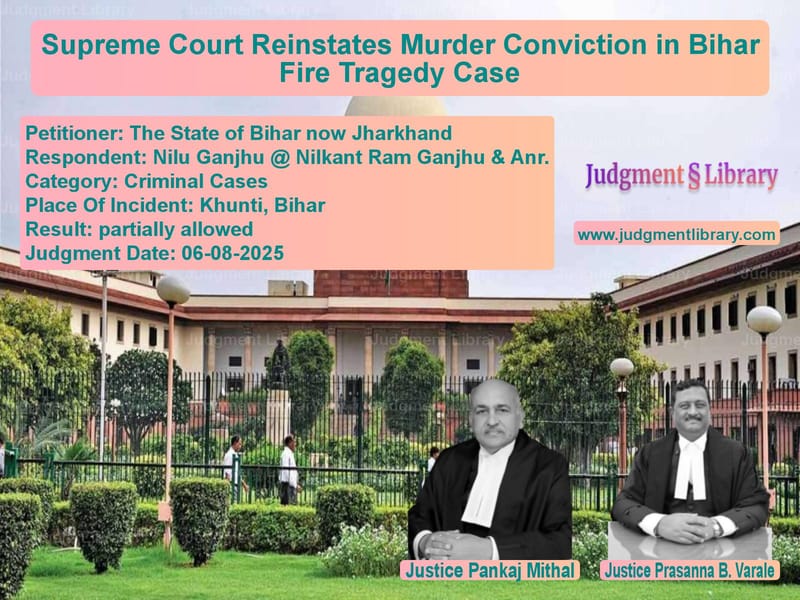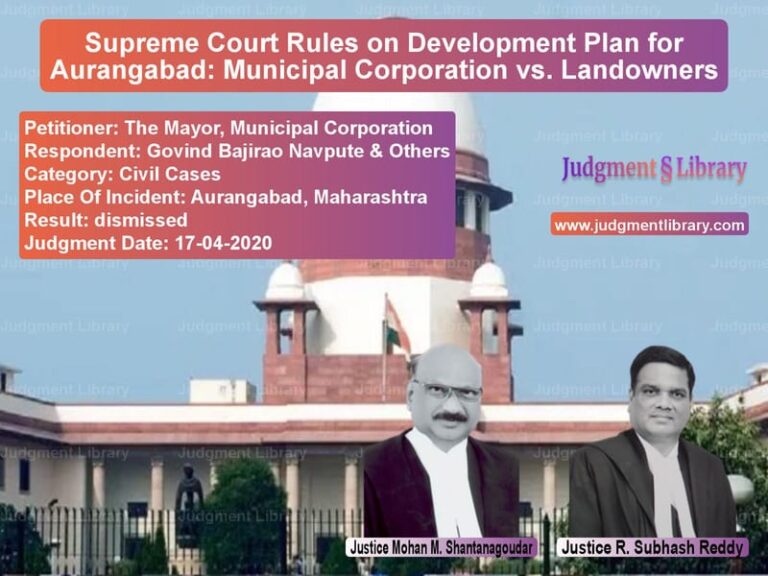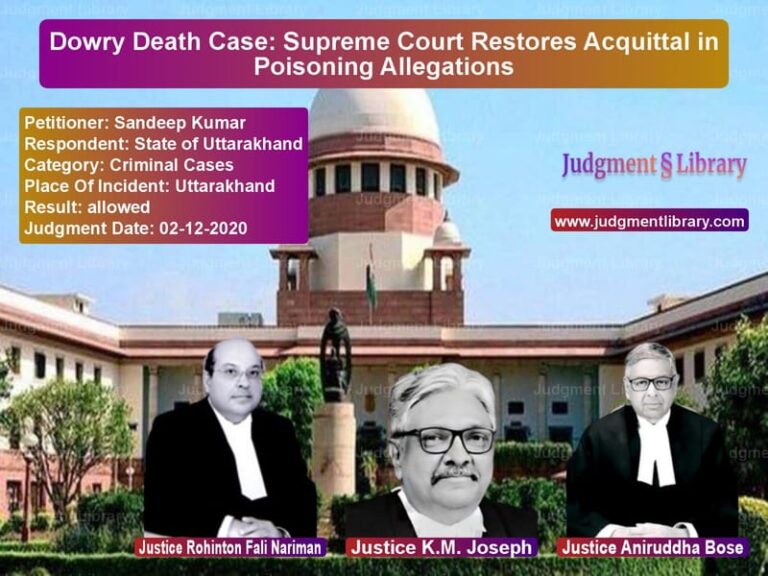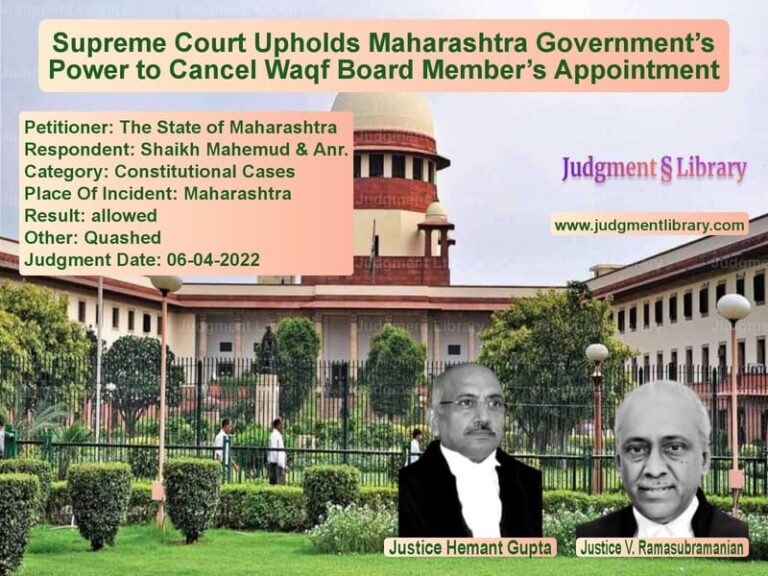Supreme Court Reinstates Murder Conviction in Bihar Fire Tragedy Case
In a significant ruling that underscores the importance of proper evidence appreciation in criminal trials, the Supreme Court of India recently overturned the acquittal of two accused persons in a tragic case involving the death of two infant girls in a fire incident. The judgment, delivered on August 6, 2025, reinstates the life imprisonment conviction of Nilu Ganjhu and Mahboob Ansari for their involvement in the 1992 fire tragedy that claimed the lives of two baby girls in Khunti, Bihar. The case presents a compelling narrative of how courts at different levels can interpret the same evidence differently, and how the highest court of the land ultimately ensures that justice prevails through meticulous examination of facts and legal principles.
The Tragic Incident and Initial Proceedings
The case dates back to the intervening night of April 1 and 2, 1992, when a devastating fire engulfed the house of Santosh Kumar Singh in Khunti, Bihar. According to the prosecution story, Singh was working as a bus agent at Khunti bus stand when, about fifteen days prior to the incident, accused Nilu Ganjhu and Mahboob Ansari had threatened him, saying they would not allow him to work as a bus agent since he was an outsider. The confrontation escalated when Nilu Ganjhu allegedly assaulted Singh, and later Mahboob Ansari caught hold of his collar and threatened him with dire consequences if he didn’t leave the business.
The tragic incident unfolded around 1:45 AM when Singh and his wife were sleeping with their two infant daughters aged three years and six months. They were awakened by the sound of an explosion and found their entire house on fire. In their desperate attempt to save themselves, they rushed out through the back door, but tragically couldn’t rescue their two daughters who perished in the flames. The prosecution alleged that immediately after coming out, Singh saw Nilu Ganjhu, Mahboob Ansari, Anil Ganjhu, and one unknown person fleeing from the scene, identifying them in the electric light.
The Trial Court, after examining the evidence, convicted all accused persons under Sections 302/34 (murder with common intention) and 436/34 (mischief by fire with common intention) of the Indian Penal Code. They were sentenced to life imprisonment for murder and seven years of rigorous imprisonment for the fire-related offense. However, the High Court of Jharkhand later acquitted all accused, leading the State to approach the Supreme Court.
The High Court’s Reasoning for Acquittal
The High Court had raised several doubts about the prosecution’s case, which formed the basis for acquitting the accused. The Court noted that “the first and foremost thing is that as per the prosecution story, the story of explosion of bomb is there but the Investigating Officer, who rushed to the place of occurrence has not found any identification of the bomb since no remains of bomb has been found from the place of occurrence.”
The High Court also expressed skepticism about the conduct of the parents, observing that “the normal behavior of the parents will be that while going out in any exigency whatsoever or in threat or any casualty, they will come out from the house along with their children in order to save their life but it is not the prosecution story herein.” This observation questioned why the parents would escape the burning house without their children.
Additionally, the High Court noted discrepancies in the identification of accused persons and the timing of events, concluding that the prosecution had failed to prove the case beyond reasonable doubt.
The Supreme Court’s Critical Analysis
The Supreme Court, comprising Justices Pankaj Mithal and Prasanna B. Varale, conducted a thorough re-examination of the evidence and found the High Court’s approach fundamentally flawed. The Court made several crucial observations that formed the basis for reinstating the conviction.
First, the Court corrected the High Court’s characterization of the case as purely circumstantial evidence, noting that “the High Court committed a serious error in treating the case of prosecution as the case based on only circumstantial evidence.” The Supreme Court emphasized that there were direct eyewitnesses to the events, particularly the informant (PW1) and his wife (PW5), who had seen the accused fleeing the scene.
The Court also addressed the High Court’s skepticism about the bomb explosion, stating that “the High Court committed a serious error in recording a finding that the prosecution failed to establish the theory of explosion of the bomb as there was no identification of the bomb nor any remains of the bomb were found on the spot.” The Supreme Court clarified that while the informant described it as a bomb, the evidence clearly showed it was some explosive substance that caused the fire, which didn’t necessarily have to be a sophisticated bomb.
The Crucial Issue of Witness Conduct
One of the most significant aspects of the Supreme Court’s judgment was its response to the High Court’s criticism of the parents’ conduct. The High Court had found it improbable that parents would escape a burning house without their children. The Supreme Court strongly disagreed with this approach, citing its previous judgment in Lahu Kamlakar Patil & Another v. State of Maharashtra.
The Court quoted verbatim from this precedent: “From the aforesaid pronouncements, it is vivid that witnesses to certain crimes may run away from the scene and may also leave the place due to fear and if there is any delay in their examination, the testimony should not be discarded. That apart, a court has to keep in mind that different witnesses react differently under different situations. Some witnesses get a shock, some become perplexed, some start wailing and some run away from the scene and yet some who have the courage and conviction come forward either to lodge an FIR or get themselves examined immediately. Thus, it differs from individuals to individuals. There cannot be uniformity in human reaction.”
This observation underscores the judiciary’s recognition that human behavior under extreme stress cannot be standardized or predicted, and witnesses should not be discredited merely because their reactions don’t match some theoretical ‘normal’ behavior.
Evidentiary Strengths Noted by the Supreme Court
The Supreme Court meticulously examined the evidence that the High Court had overlooked or misinterpreted. The Court noted that the informant (PW1) had consistently identified the accused persons, knowing them personally, and had seen them in the electric light while they were fleeing. His testimony was corroborated by his wife (PW5) and other witnesses.
The Court also emphasized the medical evidence presented by PW4 Dr. Kumar, who had conducted the autopsy and confirmed that the deaths were due to fire burns. The informant and his wife had also suffered burn injuries, further corroborating their presence in the fire.
Regarding the defense arguments about the short time between the incident and the FIR recording, the Supreme Court found nothing unusual, noting that prompt FIR recording actually strengthens the prosecution case rather than weakening it.
The Separate Case of Alibi
In a related appeal concerning accused Dhanushdhari Ganjhu, the Supreme Court took a different view. This accused had raised a defense of alibi, claiming he was admitted in Madhuri Nursing Home, 38 kilometers away from the crime scene, during the incident. The Court examined the medical records and the testimony of Dr. Sinha (DW1) and found that “the respondent-accused Dhanushdhari Ganjhu was successful in establishing his defence of alibi before the Trial Court.” The Court accepted that it was practically impossible for him to have traveled 38 kilometers in the night while being under medical treatment. Consequently, the Court dismissed the State’s appeal against his acquittal.
The Final Ruling and Its Implications
After a comprehensive analysis, the Supreme Court concluded that “the High Court erred in reversing the said conviction by adopting an erroneous and unsustainable appreciation of evidence.” The Court allowed the State’s appeal against Nilu Ganjhu and Mahboob Ansari, thereby reinstating their conviction and life imprisonment sentence. The Court directed them to surrender before the Trial Court within two weeks.
This judgment serves as an important precedent on several aspects of criminal jurisprudence: the appreciation of eyewitness testimony, the assessment of witness conduct under stress, the evaluation of alibi defenses, and the proper characterization of evidence as direct or circumstantial. It reinforces the principle that appellate courts should be cautious in overturning trial court convictions based on speculative inferences rather than concrete evidentiary flaws.
The Supreme Court’s intervention in this case ensures that after more than three decades, justice is finally served for the tragic deaths of two innocent children, while also demonstrating the judiciary’s commitment to ensuring that convictions are based on proper appreciation of evidence rather than technicalities or unrealistic expectations of human behavior.
Petitioner Name: The State of Bihar now Jharkhand.Respondent Name: Nilu Ganjhu @ Nilkant Ram Ganjhu & Anr..Judgment By: Justice Pankaj Mithal, Justice Prasanna B. Varale.Place Of Incident: Khunti, Bihar.Judgment Date: 06-08-2025.Result: partially allowed.
Don’t miss out on the full details! Download the complete judgment in PDF format below and gain valuable insights instantly!
Download Judgment: the-state-of-bihar-n-vs-nilu-ganjhu-@-nilkan-supreme-court-of-india-judgment-dated-06-08-2025.pdf
Directly Download Judgment: Directly download this Judgment
See all petitions in Murder Cases
See all petitions in Attempt to Murder Cases
See all petitions in Bail and Anticipatory Bail
See all petitions in Custodial Deaths and Police Misconduct
See all petitions in Judgment by Pankaj Mithal
See all petitions in Judgment by Prasanna Bhalachandra Varale
See all petitions in partially allowed
See all petitions in supreme court of India judgments August 2025
See all petitions in 2025 judgments
See all posts in Criminal Cases Category
See all allowed petitions in Criminal Cases Category
See all Dismissed petitions in Criminal Cases Category
See all partially allowed petitions in Criminal Cases Category







